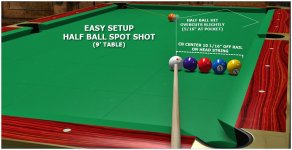I like keeping my sightline over/along my stick. It allows me to live-monitor my stroke for straightness/accuracy and also to "measure" the cut by pointing the stick a precise distance from the OB contact point.
But once upon a time I liked to sight from contact point-to-contact point, especially for thin cuts, trusting my ability to stroke my stick accurately while sighting beside it rather than over it.
Do you make that choice (or choose another option) consciously?
pj
chgo
But once upon a time I liked to sight from contact point-to-contact point, especially for thin cuts, trusting my ability to stroke my stick accurately while sighting beside it rather than over it.
Do you make that choice (or choose another option) consciously?
pj
chgo

